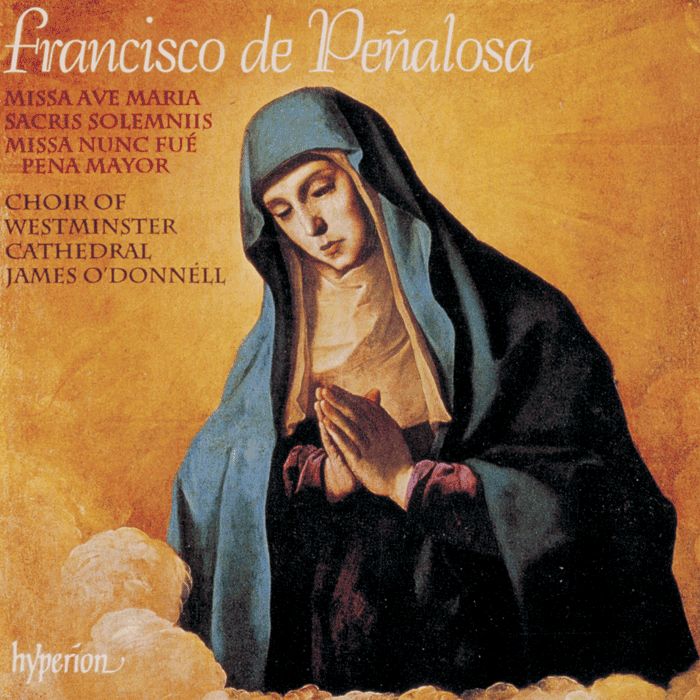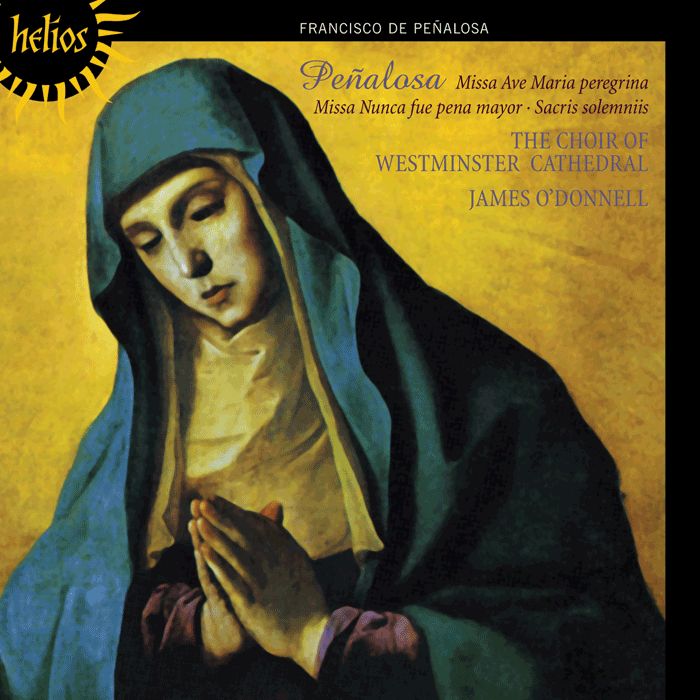Francisco de PEŅALOSA. Masses / Westminster Cathedral Choir

medieval.org
Hyperion CDA66629 (1993)
Helios CDH55326 (2011)
julio de 1992
Westminster Cathedral, London
MISSA
AVE MARIA PEREGRINA
01 - Kyrie [4:50]
02 - Gloria [6:25]
03 - Credo [9:25]
04 - Sanctus [4:52]
05 - Benedictus [3:05]
06 - Agnus Dei [6:32]
07 - Sacriis solemnis (motet)
[6:24]
MISSA NUNCA FUE PENA MAYOR
08 - Kyrie [3:38]
09 - Gloria [6:24]
10 - Credo [8:03]
11 - Sanctus [3:07]
12 - Agnus Dei [3:44]
CHOIR OF WESTMINSTER CATHEDRAL
James O'Donnell, The Master of Music
Francisco de Peñalosa
was born probably in 1470 and almost certainly at Talavera de la Reina,
near Madrid. He was undoubtedly fortunate that his career as a composer
and singer coincided with the beginning of Spain’s Golden Age: it
spanned the time of the conquest of Granada and the final expulsion of
the Moors, the discovery of the New World, the unification of the
Spanish kingdoms of Castile and Aragon under the Catholic Monarchs
Ferdinand and Isabella, and the consequent beginnings of Spain’s
rapid rise to the position of dominant world power in the sixteenth
century. In music, under the pervasive influence of the international
‘Flemish’ style, Spanish composers of real quality and
character began to emerge in the new and favourable artistic and social
conditions. As a composer, Peñalosa was the most important
figure in this, the generation before Morales.
The earliest extant document referring to Peñalosa is dated 11
May 1498 when he was accepted as a singer in the Chapel of Ferdinand V
of Aragon. Later, in 1511, he was also appointed maestro de
música in the household of Ferdinand’s grandson, although
still remaining with Ferdinand until his death in 1516. His long
association with the cathedral at Seville began through the gift of a
‘benefice canonry’ in 1505/6, to which he succeeded despite
the opposition of the cathedral Chapter. This was to cause intermittent
trouble due to prolonged absences, especially when Peñalosa was
in Rome from 1517 probably until 1525 (although he had been in Seville
briefly after the death of Ferdinand). The Seville Chapter protested at
his absence, despite requests for tolerance even from the Pope:
‘Among the singers in our chapel on solemn occasions is our
beloved son, Francisco de Peñalosa … musician
extraordinary [who] displays such exquisite art … that we
fervently desire his continuing presence.’ When he returned to
Seville in 1525 he became Cathedral Treasurer, a position he held until
his death in 1528. He lies buried close to Guerrero in the chapel of La
Virgen de la Antigua in Seville Cathedral.
Peñalosa’s religious music includes all the standard forms
of the time—probably he had an active composing career of about
twenty years, producing music for use in the Aragonese court. His
sojourn in Rome seems to have been solely as a singer. None of his
music is preserved there (in contrast with music by lesser
contemporaries such as Illanas and Escribano) and the greater part of
his works are preserved in manuscripts which can be associated with the
Aragonese Royal Chapel.
While incorporating a wide variety of compositional techniques,
Peñalosa’s music is in general less complex than much
written by his Franco-Flemish contemporaries. Striking stylistic
features common in the music of composers such as Nicholas Champion,
Pierre de La Rue, Marbrianus de Orto, Alexander Agricola, who were in
Spain with the chapel of Philip the Fair in 1501/3 or 1505/6—for
example, ostinato, imitation, cambiata figurations, canon—are all
present, yet the music almost always remains simpler, more austere,
perhaps much more influenced by the music of Josquin Des Prez, who was
to remain the most famous and highly regarded foreign composer in Spain
throughout the sixteenth century. Nowhere is it possible to find an
equivalent to the boisterous rhythmic multiplications of the cadential
drive that closes the second Kyrie of Nicholas Champion’s Missa
supra Maria Magdalena (copied in a Toledo choirbook), or of the
complex mensuration canons of Pierre de La Rue’s Missa
L’Homme armé. Yet Peñalosa’s cadential
passages (for example, his setting of ‘Amen’), in the
Masses no less than in the motets, shows an endless variety and
fertility of imagination. His expressive purpose, shown to the greatest
degree in the striking simplicity and, at the same time, in the great
variety of texture and figuration in the motets, where the response to
the various texts might be expected to yield such results, is
demonstrated no less in the more abstract genre of the Mass. Indeed,
Peñalosa’s music has a strength of character and
individuality unmistakably its own, no matter what it shares with
others in a common musical language or technique.
Peñalosa’s Masses are based mainly on secular models, a
not uncommon occurrence throughout Europe at the time. The six
(complete) Masses by Peñalosa which have come down to us are the
(obligatory!) Missa L’Homme armé, the Missa
Por la mar (which partially quotes the L’Homme armé
tune in the Sanctus), the Missa Adieu mes amours, the Missa
El Ojo, the Missa Nunca fue pena mayor, and finally the Missa
Ave Maria peregrina, the only chant-based Mass.
It is not known if any of the Masses were written for any specific
occasion. However, there is no Benedictus copied in the only source for
the Missa Nunca fue pena mayor: with only one Agnus Dei
(compared to the standard two of the other Masses and the three of the Missa
El Ojo), which nevertheless seems textually complete, and a
particularly brief Hosanna, it may be that this is intentionally a
‘short’ Mass.
In the Missa Ave Maria peregrina, mainly for four voices,
Peñalosa incorporates sections of the plainchant Ave Maria.
However, in addition he uses long sections of Salve regina:
beginning in Sanctus and Hosanna, the tenor sings the chant melody
associated with the words ‘Spes nostra’ and ‘Illos
tuos misericordes’. As a final tour de force Peñalosa
constructs the climactic five-voice Agnus Dei around a secular tune,
that of the Hayne chanson De tous biens plaine (there being an
obvious symbolic significance of a love song in a Mass to the Virgin),
in cancrizans canon against the section of the Salve regina
beginning at the ‘Vita dulcedo’ verse, all the while
surrounding the two structural voices with flowing counterpoints of his
own invention.
The four-voice Missa Nunca fue pena mayor uses material from
the three-voice villancico of the same name by the Flemish composer
Urrede (Johannes Wreede, of Bruges), who was appointed as singer and
maestro to the Aragonese Chapel on the 27 June 1477. He had previously
been in the service of the first Duke of Alba, García
Alvárez de Toledo, the author of the words for Nunca fue
pena mayor. This piece has pride of place in the Cancionero
Musical de Palacio, appearing at the head of that great manuscript
collection of late fifteenth-century Spanish secular music. It became
widely known throughout Europe, in marked contrast to other Spanish
repertoire of the time. It was even printed (with an additional fourth
part) in Petrucci’s Harmonice Musices Odhecaton A,
published in Venice in 1501. This was the earliest printed collection
of part music (in fact apparently compiled by a Castilian, Petrus
Castellanus!).
Indeed, Peñalosa was not the only composer to use this song, as
Pierre de La Rue’s Mass of the same name appeared in
Petrucci’s Misse Petri de la Rue in 1503. As he had been,
since 1492, in the service of Philip the Fair, and married in 1497, to
Juana, daughter of Ferdinand and Isabella, Pierre de La Rue would have
had a notable Spanish connection even before his first trip to Spain in
1501/3. The sources for this Mass (and its publication in 1503)
probably indicate that it was written prior to 1501. Might it have been
specially composed in commemoration of these royal events? For
Peñalosa’s Mass we have even less grounds for conjecture,
but in style it is perhaps the most ‘Flemish’ of his Masses
and as such it could well have been a Spanish composer’s response
to foreign competition!
Another Flemish contemporary, Matthaeus Pipelare, quoted the tenor of Nunca
fue pena mayor in his Memorare Mater Christi, a Hymnus
de septem doloribus dulcissimae Mariae Virginis. The latter piece
sings of the seven sorrows of the Virgin, with the third voice of the
seven being the tenor of Nunca fue pena mayor (the text of
which sings of the pain of love, beginning with ‘Never was there
greater pain’), and its use has an obvious symbolic intent. So
with Peñalosa, the use of the villancico as a model may also be
a tribute to the Virgin, though less obviously so than with the Ave
Maria and Salve regina chants in the Missa Ave Maria
peregrina.
The melody of the Urrede villancico is quoted exactly by
Peñalosa in various places in the Mass, for example, in Kyrie I,
where the first half of the tune is sung in the uppermost voice.
Elsewhere, sometimes it appears in augmented note values (but otherwise
unaltered), notated as a mensuration canon, as in Gloria, apparently
combined with sections of the plainchant Gloria XV, which begins at
‘et in terra’ with the same rising melodic configuration.
The complete melody of Part 2 of the villancico is quoted in the bass,
beginning at the triple-time ‘Cum Sancto Spiritu’. In
Sanctus, only the first part of the tune is quoted, in the topmost
voice, but according to the canonic indication: Prima ut iacet;
secunda in dupplo (‘the first time as it stands; the second
with double values’). Meanwhile the other voices interweave their
own increasingly fragmentary sequential ostinato counterpoints,
combining in one of Peñalosa’s most strange and striking
textures.
Not only does Peñalosa quote the melody (the top voice) of
Urrede’s composition, but he uses from time to time the tenor
(middle voice of the original three-part version of the villancico):
Part 1 is sung by the tenor in the second Kyrie, and in the Agnus Dei,
most notably, the same section is sung in long note values by the alto.
No quotation of the full polyphonic texture of the villancico appears
in the Mass.
Only one polyphonic verse of Peñalosa’s Corpus Christi
Hymn Sacris solemniis survives—perhaps only one was ever
written. In this recording, Bruno Turner’s reconstruction is
used, so that for the complete Hymn Peñalosa’s polyphony
alternates with the popular melody that was used in Spain from the
fifteenth to the nineteenth century. The Toledo books (1515) and almost
all others for over four hundred years give the tune in black breves
and semibreves. The polyphony incorporates this melody in its texture
in a slower time, surrounding it with lively counterpoint. For the
technically minded, the tune’s original black brevis is the
equivalent of the white semibrevis of the polyphony, thus this same
tune, when embedded in the polyphony, is slowed threefold.
Martyn Imrie © 1993


